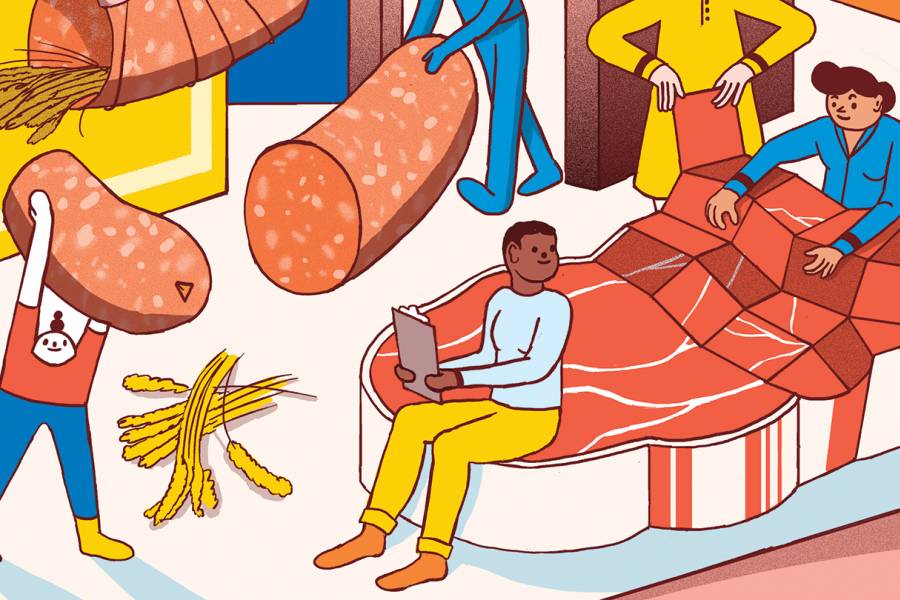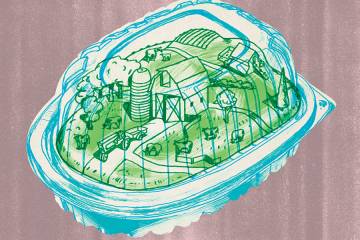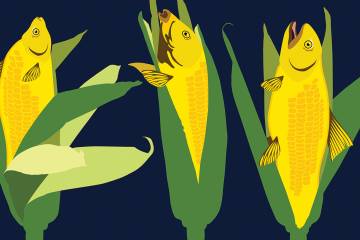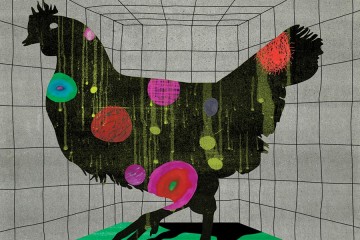It takes about 90 seconds of flipping and stirring for Josh Hyman to whip up a skillet of fluffy, pale yellow scrambled eggs. He's in an industrial kitchen in San Francisco, and I'm 3,000 miles away on my farm in rural Tennessee, watching Hyman cook via Skype. He tips the craggy yellow mounds out of the pan and onto the plate, the eggs jiggling as they slide.
Except: These aren't eggs. They're proteins from mung beans, manipulated—thanks to some proprietary science—to act, look, and taste like the real thing. Even from the vantage point of my computer screen, they look and cook just like the eggs that my chickens lay. If Hyman hadn't told me this breakfast's origin story, I never would have guessed.
Hyman works as the lead project manager for product development at JUST, a San Francisco–based startup that's re-engineering popular foods. JUST is spinning yellow peas into vegan mayo and mung beans into eggs, which means in addition to Michelin star–rated chefs, the company has computational biologists and scientists of cellular agriculture in their test kitchen.
JUST, which was founded in 2011, is one of several new global companies banking on the future of alternative protein. Humans have been manipulating plants into meatlike approximations for centuries—think tofu and tempeh—and today you can get hemp milk foam for your latté, order a barbecue sandwich made of jackfruit, or scoop a ladleful of protein-packed cricket powder into a bulk bag at your organic grocery store. Companies like JUST also hope to take it a step further by not only manipulating plants and insects but also using the cells of animals to produce cell-cultured meat. Imagine your kid's chicken nuggets or your next filet mignon coming courtesy of a bioreactor in a lab.
Video credit: JUST
According to numbers compiled by the Alternative Protein Show, an annual event in San Francisco, there are around 100 companies battling to build better plant, seed, insect, and lab-grown meat alternatives. Dozens of incubator spaces and venture capital firms in places like Silicon Valley are helping to fund this research, which promises to change how we eat. When Richard Branson, the founder of Virgin Atlantic, announced in 2017 that he was investing in the alt-protein company Memphis Meats, he did so, he said, because he believes that "in 30 years or so we will no longer need to kill any animals and that all meat will either be clean or plant-based, and also be much healthier for everyone."
This alt-meat movement is being made possible, in part, by what's been called the fourth industrial revolution by Klaus Schwab, founder and executive chairman of the World Economic Forum. This revolution "is characterized by a range of new technologies that are fusing the physical, digital, and biological worlds," according to the WEF, and it's perhaps best summed up with the word du jour: disruption. As ride sharing upended the taxi industry, and online streaming put the screws to cable, companies like JUST hope to harness technology and computing to disrupt the feedlot-to-slaughterhouse pipeline and create foods that are more sustainable, healthy, and viable for a planet set to have 10 billion people to feed by the middle of this century.
"The alt-meat movement is the idea that we take the best of science, the best of engineering, and we can figure out alternatives to eating meat that will be healthy for us—or at least no worse—and that can be produced in sufficient quantities at a reasonable cost to be able to provide for the nutrition of today's and tomorrow's population," says Ruth Faden, the founder of the Johns Hopkins Berman Institute of Bioethics. But will we eat it? And what unintended consequences might lurk amid the disruption?

America has a protein problem. According to the USDA, Americans ate more meat in 2018 than in any previous year, and most of it came from factory farms. "High-protein diets that contain lots of red meat and high-fat dairy products have implications of higher cholesterol, higher risk of heart disease," says Jessica Fanzo, the Bloomberg Distinguished Associate Professor of Global Food & Agricultural Policy and Ethics at the Berman Institute.
Christine McKinney, a registered nutritionist at Johns Hopkins Bayview Medical Center, says that, according to data from the 2015 to 2020 Dietary Guidelines for Americans, men, in particular, may be eating too much protein. While protein is an essential macronutrient, and it can have benefits for dieters—like making you feel full longer—how much you need depends on your sex, age, size, and activity level. (As a basic starting point, McKinney recommends 0.8 grams of protein per kilogram of body weight. So, a 180-pound man would need 52 grams, or a 4-oz steak and a Greek yogurt per day.)
At the same time, meat has "a big environmental footprint, as opposed to plant-based proteins," says Fanzo. Animal-based proteins, especially those from large land mammals—like cows—is a climatological nightmare. A 2015 study by the Johns Hopkins Center for a Livable Future found that if current meat and dairy consumption levels continue, we'd likely exceed by 2050 the catastrophic 2-degree-Celsius global temperature rise that climate scientists have warned about. Perhaps even more concerning is we're going to hit this number even with drastic steps to reduce emissions in other areas, like manufacturing. That's because livestock production is responsible for 14.5 percent of all human-attributable greenhouse gas emissions—more than the entire transportation sector.
Then there are the ethical issues, as vividly displayed in popular documentaries, such as Food Inc. and Cowspiracy. "Right now, the way we produce much of our meat, and many of our dairy products, involves practices that are inimical to the well-being of animals," says Faden. "Animals live with constant stress, and in significant pain."
Even knowing all of this, changing humans' long-standing relationship to meat is no small task. Fanzo is currently serving on the United Nations Committee on Food Security, and her research focuses, in part, on how to build a more equitable, ethical, and sustainable food system, where everyone—particularly those in poorer countries—has access to proper nutrition. For rich countries like ours, it's mostly about learning to curb cravings for flesh. Fanzo says that subtle consumer nudges like Meatless Mondays have had a small impact in getting Americans to reach for alternatives at least one day a week. "We know there are lots of things you can do around media and education campaigns, fiscal measures like taxation, subsidies, other kinds of economic incentives, school and workplace nudges," she says.
But the best way to guarantee people will eat more alt-protein is simple: Make it taste as good as the real thing.

There are two primary ways that alt-protein companies are approaching taste.
The first is continuing the long history of manipulating plants into meatlike mainstays. Tofu has been a staple in China for more than 2,000 years, and seitan dates back to at least the sixth century.
From a biological standpoint, cows are machines that turn grass and grain into concentrated protein. And it takes a lot of grass and grain to fatten them up. What if science could do the same thing, and could do it in a more energy-efficient manner? "These companies are saying, why don't we create meat directly from plants essentially by reverse engineering what the cow does," says Faden.
Impossible Foods, a company now selling its Impossible Burgers in cities throughout the United States, is using this approach. The company has focused on a molecule called heme, which gives steaks and chops their meaty taste. "Heme is a small iron-carrying molecule found in all living organisms," explains Rebekah Moses, senior manager of impact strategy at Impossible Foods. "It's particularly abundant in animals like cattle, sheep, and even tuna in the form of myoglobin—and as a result, it's important to how products of those animals taste, smell, and cook."
The scientists at Impossible Foods found that leghemoglobin, a protein in legumes, also contains heme. They learned how to grow leghemoglobin proteins via yeast fermentation and the end result is a protein-rich burger that tastes surprisingly like the real deal and even seems to "bleed."
Whether you a muscle-bound meat head, or just started tracking your macros, the Muscle Maker Grill has got that #ImpossibleBurger to pump up your tastebuds. via @AP https://t.co/etYW9ijjyR pic.twitter.com/mqHa44Z7v6
— Impossible Foods (@ImpossibleFoods) February 22, 2019
At JUST, Udi Lazimy, the company's global plant sourcing lead, travels the world looking for unique plants that may offer proteins with specific qualities. For example, the yellow peas in the company's mayo contain a specific protein that acts as an emulsifier. The mung beans in its eggs, meanwhile, house a protein that is structurally like gelatin, and that's how Hyman got his scrambled "egg" to jiggle. The addition of this protein, however, means that the fake eggs won't work in baking applications, something the company is working on, and one of the many challenges that scientists face in trying to mimic the properties of meat and dairy.
The second approach to alt-protein is to create real meat, but without the animal suffering or impact on the land. With what's referred to as clean meat, "you use stem cell technology and, in a lab, you essentially generate muscle tissue," Faden explains. "You are eating beef, but the beef is not from an actual cow that was raised and then slaughtered; it's generated from the cells of a real cow."
This works by extracting a few cells from an animal through a simple biopsy procedure. According to JUST, even the cells on the end of a plucked feather could be enough to grow chicken meat. The cells are then put into a solution, similar to what is used in biotech applications, and they multiply. It is believed that one biopsy could provide steaks for years. No feedlots, no slaughterhouses, and no antibiotics required.
So far, JUST and companies like it have succeeded in growing some meat in culture, but they are still working on giving it the same toothsome feel as the real thing. The solution to mouthfeel may come from mushrooms, says Ricardo San Martin, the head of the Alternative Meats Lab in UC Berkeley's College of Engineering. Right now, students in his lab are stripping fungi of everything but their cellular structure. That fibrous skeleton then becomes a scaffold for growing beef, pork, or chicken cells.
Disrupting any industry, though, leads to myriad questions, and at the Berman Institute, ethicists are examining the issues surrounding alt-meat from every angle. Faden and Fanzo are both engaged in understanding the implications, for instance, of displacing so many ranchers from their livelihoods. "They are clearly going to be the losers," says Faden about what may happen if lab-grown meat replaces a sizable chunk of the protein consumed in the U.S. "It's also the laborers, and the people in the slaughterhouses, and so on," says Faden.
Also see
Also unknown is the exact amount of energy the factories growing cultured meat will require. San Martin says he's not convinced that the overall energy requirements of running a large meat-growing factory are that much lower than those required to raise animals on a farm, especially for poultry. Because beef is grain-and water-intensive, it probably will be less resource-intensive to grow in a lab. However, because most alt-meat companies are privately held, San Martin says he has yet to see unbiased data on exactly how much energy is being consumed for every pound of meat made.
There's also the question of what is in the medium used to grow the meat. Every company we spoke to for this story declined to offer specifics, but JUST went as far as saying it's similar nutrient-wise to what the cow might dine on in real life. Those ingredients would still need to be farmed, San Martin says. What happens if we rip up pastures to produce portions of the growth medium needed to make tons of clean meat? Pasturelands, which can include several types of grasses and clovers, have value. They provide habitat for animals, for example, and clover is a great source of pollen for bees. "Is this replacing butter with margarine?" he asks, adding, "we have to be very careful with unintended consequences of the solutions."
Alt-meat will also require an overhaul of regulatory oversight. Who monitors meat grown in a lab? In November 2018, the USDA and the FDA released a written statement announcing that both agencies would "jointly oversee the production of cell-cultured food products derived from livestock and poultry." The FDA would monitor cell collection, cell banks, and cell growth and differentiation, and then the USDA would take over, including overseeing the production and labeling of food products derived from the cells of livestock and poultry.
And what will lab-grown meat be called? "The people in the meat-producing industries are deeply fighting this," Faden says about alt-meat. "They're saying, you can call it what you want, but you can't call it meat."
Jan Dutkiewicz, the Connie Caplan Post-Doctoral Fellow in Johns Hopkins' Political Science Department, researches the politics of American agribusiness, with a focus on meat consumption and production, including how meat companies encourage consumers to eat more ribs and chops. He believes that Americans can be convinced to make the switch to alt-meat, in part because we love animals—or at least we like to think we do, even if our actions say otherwise.
"There is a recent study by the Sentience Institute, that I use a lot," he says, pointing to its finding that 69 percent of Americans think factory farming is a pressing issue. "It also found that 49 percent of Americans surveyed believed that we should not have factory farms, and 47 percent believed that we should get rid of high-speed slaughterhouses," he says.
While attitudes around animal welfare are encouraging, he feels low prices—brought about by economies of scale for massive soy and corn operations and subsidized crop insurance—have made daily carnivorousness a tough habit to break. "Consumers, we know, make most of their decisions based on taste and price, and only later about ethical considerations," says Dutkiewicz, who is working on a book titled Capitalist Pigs, which examines how politics may impact the future of the meat industry—including, possibly, the alt-meat industry. "So, when people buy fair trade coffee their considerations are probably, first, can I afford this? Number two, is it good? And number three, oh I guess I'd like to support fair trade."
Josh Tetrick, co-founder and CEO of JUST, is keenly aware of how price dictates the success or failure of his alt-meat offerings. "Food needs to taste really good. Food needs to make me feel good, and I need to be able to afford it. This was true a thousand years ago. It's true today. It will probably be true a thousand years from now."
Right now, lab-grown meat isn't affordable. Aleph Farms, a company in Israel, claims to be the first to have gotten its lab-grown beef close to steak form. However, the final cost for a steak is coming in around $50. In a December 2018 interview with The Wall Street Journal, a representative for the company admitted that it didn't taste all that great, and that's going to be a hard pass for most Americans.
Dutkiewicz, who is a vegan, says, "I am not the target consumer" of alt-meat, and yet he supports the development of these products if they "are going to ideally make factory farming obsolete. And in making factory farming obsolete, we'll save billions, and I want to repeat that number, billions of animal lives," he says.
Fanzo wants to see Americans make more ethical eating choices, even if those choices are small shifts. She's working with Faden and several Hopkins colleagues on a project that they hope will help make it easier for consumers to make healthy, and ethical, choices. Called Choose Food Project: Ethically Benchmarking Food Systems, it will help consumers make informed decisions about what's for dinner. Choose Food has already drawn on the expertise of retailers, farmers, water conservationists, food safety specialists, nutritionists, and academics focused on animal welfare, labor and human rights, crops and agriculture, the environment, and the evolution of standards.
Crickets anyone? Fanzo doesn't think that Americans are suddenly going to plate up bugs instead of burgers. "Having to get over the 'yuck' factor can be significant," she says. What's likely going to be more effective is encouraging "flexitarian" eating, where many meals are plant-based, but it's not a sin to eat the occasional steak. In 2018, Fanzo published a paper in Nature, which showed that a flexitarian diet could help reduce greenhouse gas emissions. That, coupled with cutting down on food waste and better farm management practices, she says, could help stem the tide on climate change while we wait for lab-grown meat to hit our plates.
Correction: An earlier version of this article contained an incorrect description of JUST's products. The magazine regrets the error.
Posted in Health, Politics+Society
Tagged center for a livable future, berman institute of bioethics, food production












